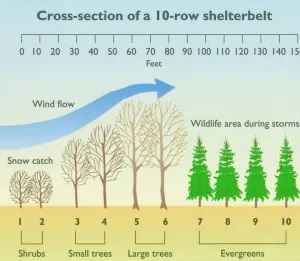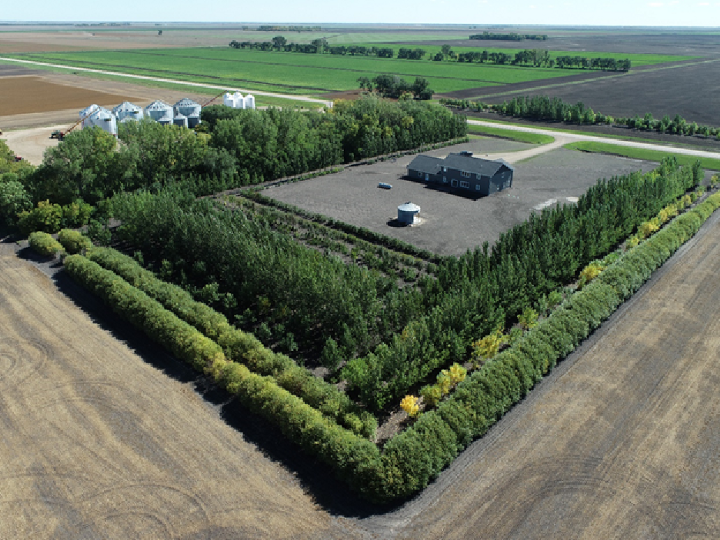

PLANNING YOUR SHELTERBELT
Planning and building your shelterbelt may seem like a monumental task, but it doesn't have to be. With a simple plan and tried and true methods you can build a shelterbelt that will not only be functional, but will bring beauty and color to your yard for generations.
Shelterbelt planning first needs to begin with the size of your yard and the amount of space you are willing to dedicate to the project. 3 to 5 rows is usually the norm with staying with the same shrub or tree species per row. This will give you an asthetically pleasing shelterbelt that has even color and height.
OUTER ROWS
The outer rows of your shelterbelt serve a very important role. They provide the first line of defence against wind and snow reaching your home or farmyard. Density of planting and shrub type are very important. These rows usually consist of Caragana, Villosa or Common Lilac, Hawthorn, Sea Buckthorn, Buffaloberry, Dogwood or Chokecherry shrubs. These shrubs, with the exception of Caragana are generally recommended to be planted every 3 to 4 feet, with Caragana being every 1-2 feet. If space permits 2 rows of Shrubs should be planted with a distance of 12-15 feet between them.
MIDDLE ROWS
The Middle Rows of trees are the taller broadleaf such as Bur Oak, Green Ash, Willow, Manitoba Maple and hybrid Poplars such as Tower, Okanese, PrairieSky and Sundancer. Spacing between trees should be approximately 8-10 feet apart and 15 feet from the outer shrub rows. These taller trees will direct the wind upward and provide a larger area of calmness downwind before the wind drops back down to ground level. It is good practice to plant at least 2 of these rows 15 feet apart to provide for good wind deflection and to have the density available to make up for any lost trees.
INNER ROWS
The inner rows of trees are usually where you'll find your coniferous trees such as Spruce and Pine. Typical species include Colorado Spruce, White Spruce, Black Hills Spruce, Crystal Blue Spruce, Baby Blue Spruce, Scots and Ponderosa Pine. Even taller growing cedars such as the Eastern Red Cedar have also been used in these rows. The Inner rows in addition to continuing the uplift of the wind is usually made of these types of trees to provide year round color and interest to your yard and provide protection for small birds and animals. The Inner row of trees should be spaced about 12 feet apart and 15 feet between additional rows. There should be about 20 feet seperating it from the middle rows to provide for the sunlight needed for the Spruce and Pine, which prefer full sun.
Other things to consider are set backs from roads and highways, which is usually 100-150 feet, but you may want to check with your town or RM. There are also set backs from buildings, underground infastructure and power lines, which again you'd like to leave about 100 feet if possible to prevent any damage, but again you can check with the town, RM or utility to ensure your ok.
There are many trains of thought on shelterbelt planning but this is the simplest method I know of to get a shelterbelt planted and growing quickly. The idea is to have fast growing trees on the outer rows to protect the inner slower growing trees on the inside. Shelterbelt planning and building may be a lot to take in, but if you keep your plan simple, draw it out and use pre-made distance poles for measuring, it can be a rewarding experience that will provide you with snow and wind protection for your property and animals, help reduce energy costs and increase the value of your property.
